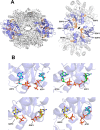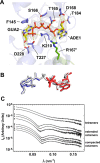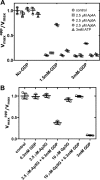The Bateman domain of IMP dehydrogenase is a binding target for dinucleoside polyphosphates
- PMID: 31416831
- PMCID: PMC6779442
- DOI: 10.1074/jbc.AC119.010055
The Bateman domain of IMP dehydrogenase is a binding target for dinucleoside polyphosphates
Abstract
IMP dehydrogenase (IMPDH) is an essential enzyme that catalyzes the rate-limiting step in the de novo guanine nucleotide biosynthetic pathway. Because of its involvement in the control of cell division and proliferation, IMPDH represents a therapeutic for managing several diseases, including microbial infections and cancer. IMPDH must be tightly regulated, but the molecular mechanisms responsible for its physiological regulation remain unknown. To this end, we recently reported an important role of adenine and guanine mononucleotides that bind to the regulatory Bateman domain to allosterically modulate the catalytic activity of eukaryotic IMPDHs. Here, we have used enzyme kinetics, X-ray crystallography, and small-angle X-ray scattering (SAXS) methodologies to demonstrate that adenine/guanine dinucleoside polyphosphates bind to the Bateman domain of IMPDH from the fungus Ashbya gossypii with submicromolar affinities. We found that these dinucleoside polyphosphates modulate the catalytic activity of IMPDHs in vitro by efficiently competing with the adenine/guanine mononucleotides for the allosteric sites. These results suggest that dinucleoside polyphosphates play important physiological roles in the allosteric regulation of IMPDHs by adding an additional mechanism for fine-tuning the activities of these enzymes. We propose that these findings may have important implications for the design of therapeutic strategies to inhibit IMPDHs.
Keywords: Bateman domain; IMP dehydrogenase; X-ray crystallography; allosteric regulation; conformational change; conformational switch; dinucleoside polyphosphates; molecular sensor; small-angle X-ray scattering (SAXS); structural biology.
© 2019 Fernández-Justel et al.
Conflict of interest statement
The authors declare that they have no conflicts of interest with the contents of this article
Figures




References
-
- Finamore F. J., and Warner A. H. (1963) The occurrence of P1,P4-diguanosine 5′-tetraphosphate in brine shrimp eggs. J. Biol. Chem. 238, 344–348 - PubMed
-
- Rapaport E., and Zamecnik P. C. (1976) Presence of diadenosine 5′,5‴-P1,P4-tetraphosphate (Ap4A) in mammalian cells in levels varying widely with proliferative activity of the tissue: a possible positive “pleiotypic activator”. Proc. Natl. Acad. Sci. U.S.A. 73, 3984–3988 10.1073/pnas.73.11.3984 - DOI - PMC - PubMed
Publication types
MeSH terms
Substances
Associated data
- Actions
- Actions
- Actions
- Actions
- Actions
LinkOut - more resources
Full Text Sources

